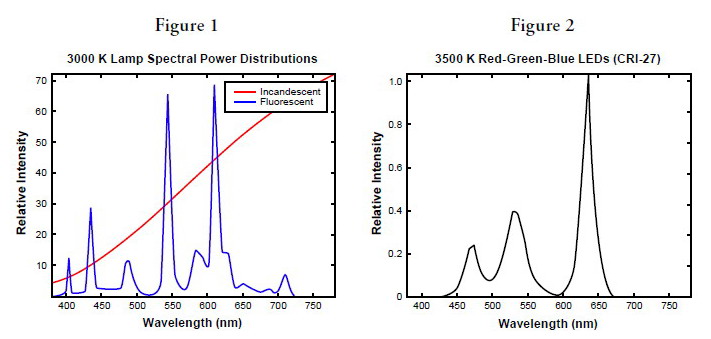The color rendering index (CRI) has been used to compare fluorescent and HID lamps for over 40 years, but the International Commission on Illumination (CIE) does not recommend its use with white light LEDs. A new metric is under development. In the meantime how should we use CRI when it comes to LEDs?
CIE Technical Report 177:2007, Color Rendering of White LED Light Sources, states, “The conclusion of the Technical Committee is that the CIE CRI is generally not applicable to predict the color rendering rank order of a set of light sources when white LED light sources are involved in this set.”
This recommendation is based on a survey of numerous academic studies that considered both phosphor-coated white light LEDs and red-green-blue (RGB) LED clusters. Most of these studies involved visual experiments where observers ranked the appearance of illuminated scenes using lamps with different CRIs. In general, there was poor correlation between these rankings and the calculated CRI values. In fact, many RGB-based LED products have CRIs in the 20s, yet the light appears to render colors well.
To understand why, we need to review what CRI is really measuring, how that relates to traditional light sources, and how LEDs differ from other light sources.
How is CRI Measured?
CRI is understood to be a measure of how well light sources render the colors of objects, materials, and skin tones. How is the CRI number actually calculated? The test procedure involves comparing the appearance of eight color samples (see upper right for an approximation) under the light in question and a reference light source. The average differences measured are subtracted from 100 to get the CRI. So small average differences will result in a higher score, while larger differences give a lower number. Of all the colors possible, only these eight are measured. Further, the samples used are pastels, not saturated colors.
CRI is calculated by measuring the difference between the lamp in question and a reference lamp in terms of how they render the eight color samples. If the lamp to be tested has a correlated color temperature (CCT) of less than 5000 Kelvin (K), the reference source is a black body radiator (approximately like an incandescent lamp). For higher CCT sources,the reference is a specifically defined spectrum of daylight. Therefore, light sources that mimic incandescent light or daylight for the eight color samples are, by definition, the ones that will score highest on the CRI.
“Tuning” the Spectrum for High CRI

Over the years, fluorescent phosphors have been tuned and refined to render those eight color samples well, i.e., very much like the incandescent or daylight references. But look at the “spikes” in the spectral power distribution (SPD) for the fluorescent source in Figure 1 below. If the phosphors were changed just slightly, shifting the emission wavelengths, the CRI score may drop significantly, but with little change in color rendering as perceived by the human eye. Phosphor-converted (PC) LEDs use broadband phosphors to score relatively high (70- 90+) on the CRI scale.
Now look at the SPD for an RGB LED in Figure 2 above. It’s similar to the fluorescent lamp in its “spikiness,” with obvious blue, green, and red peaks. It scores only 27 on the CRI metric because those particular wavelengths don’t perform like incandescents on the eight sample CRI colors. Regardless of low CRI, the white light generated by commercial RGB LED clusters is usually visually appealing. One possible reason is that they typically tend to increase the perceived saturation (chroma) of most colors without producing objectionable hue shifts.
Similarly, neodymium incandescent lamps (sold under brand names including GE Reveal®, Philips Natural Light, and Sylvania DaylightTM) have low CRIs, but objects illuminated with them appear brighter and livelier when compared with unfiltered incandescent lamps.
Recommendations
A long-term research and development process is underway to develop a revised color quality metric that would be applicable to all white light sources. In the meantime, CRI can be considered as one data point in evaluating white LED products and systems. It should not be used to make product selections in the absence of in-person and on-site evaluations.
Specifically, we recommend the following:
1. Identify the visual tasks to be performed under the light source. If color fidelity under different light sources is critically important (for example in a space where color or fabric comparisons are made under both daylight and electric lighting), CRI values may be a useful metric for rating LED products.
2. CRI may be compared only for light sources of equal CCT. This applies to all light sources, not only to LEDs. Also, differences in CRI values of less than five points are not significant, e.g., light sources with 80 and 84 CRI are essentially the same.
3. If color appearance is more important than color fidelity, do not exclude white light LEDs solely on the basis of relatively low CRI values. Some LED products with CRIs as low as 25 still produce visually pleasing white light.
4. Evaluate LED systems in person and, if possible, on-site when color fidelity or color appearance are important issues.





